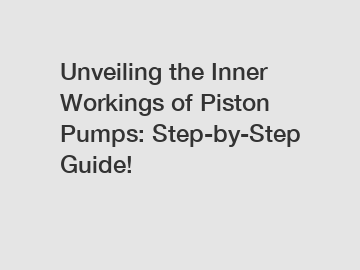Jan. 14, 2024
Energy
Piston pumps are a crucial component of various industrial processes, providing efficient fluid transfer and power transmission. Although they work silently behind the scenes, understanding their inner workings can greatly enhance your knowledge of fluid dynamics and mechanical engineering. In this comprehensive guide, we will delve into the intricate details of piston pumps, unveiling their step-by-step functioning to demystify this vital piece of machinery.
1. What Are Piston Pumps?
Piston pumps, also known as reciprocating pumps, are hydraulic devices that use the reciprocating motion of a piston within a cylinder to displace fluids. These pumps are widely utilized in industries such as oil and gas, chemical processing, agriculture, and water treatment. The versatility and efficiency of piston pumps make them a preferred choice in many demanding applications.

2. Components of a Piston Pump.
To comprehend the inner workings of a piston pump, it is important to understand its key components:
a. Cylinder: The cylinder is the main body of the pump, housing the piston and controlling fluid movement. It is typically made of durable materials such as steel or alloy.
b. Piston: The piston, which fits snugly inside the cylinder, is responsible for generating pressure and displacing the fluid. Pistons are generally made of materials like stainless steel or ceramic, offering strength and corrosion resistance.
c. Valves: Piston pumps are equipped with intake and discharge valves to regulate fluid flow. These valves ensure a unidirectional flow through the pump, maintaining efficiency and reducing backflow.
d. Seals and O-rings: Seals and O-rings are crucial components that prevent fluid leakage between the piston and cylinder walls. They create a tight seal, allowing the pump to build and maintain pressure effectively.
3. Step-by-Step Functions of a Piston Pump.
Now let's dive into the intricacies of how a piston pump works:
Step 1: Intake Stroke.
- As the piston initially moves away from the cylinder valve, it creates a vacuum that draws fluid into the cylinder chamber through the intake valve.
- The intake valve opens, allowing the fluid to flow into the chamber.
Step 2: Compression Stroke.
- The piston then starts moving towards the cylinder valve, compressing the fluid within the chamber.
- The compression builds pressure and forces the discharge valve closed, preventing backward flow.
Step 3: Discharge Stroke.
- As the piston continues to move towards the cylinder valve, the increased pressure opens the discharge valve.
- The pressurized fluid is expelled from the chamber into the discharge line, ready for further application.
Step 4: Recoil Stroke.
- Once the fluid is discharged, the piston moves back to its initial position due to its inherent mechanical properties or by external forces.
- This prepares the pump for the next intake stroke.
4. Advantages and Applications of Piston Pumps.
Piston pumps offer numerous advantages, making them essential in various industries:
a. High Pressure Capability: Piston pumps can handle high pressures, making them ideal for applications that require significant force like water jet cutting, hydraulic presses, and material extrusion.
b. Versatility: These pumps can handle a wide range of fluids, from thin, low-viscosity liquids to highly viscous substances, including abrasive materials.
c. Efficient Operation: Piston pumps provide a smooth and continuous flow while maintaining high efficiency, ensuring consistent performance across a variety of applications.
d. Wide Range of Sizes: From small portable pumps suitable for domestic use to large-scale industrial units, piston pumps are available in various sizes to meet diverse requirements.
5. Maintenance and Care.
To ensure the longevity and optimum performance of piston pumps, regular maintenance and care are essential. Here are a few important tips:
a. Check fluid quality and cleanliness regularly to avoid contamination and damage to sensitive components.
b. Inspect seals and O-rings for wear or damage, replacing them promptly to prevent leakage.
c. Keep moving parts lubricated to minimize friction and prolong the life of the pump.
d. Follow manufacturer's guidelines for scheduled maintenance, including cleaning and adjusting valves, and replacing any worn-out parts.
Conclusion.
Piston pumps play a vital role in numerous industrial processes, and understanding their inner workings can empower you with invaluable knowledge of fluid dynamics and machinery. By following our step-by-step guide, you have gained insights into how these powerful devices operate and their significance in various applications. With proper maintenance and care, piston pumps can continue to deliver efficient fluid transfer and reliable performance for years to come, contributing to the smooth functioning of numerous industries worldwide.
The company is the world’s best sanitary diaphragm pump supplier, vacuum piston pump works, air operated diaphragm pump problems supplier. We are your one-stop shop for all needs. Our staff are highly-specialized and will help you find the product you need.
If you are interested in sending in a Guest Blogger Submission,welcome to write for us!
All Comments ( 0 )